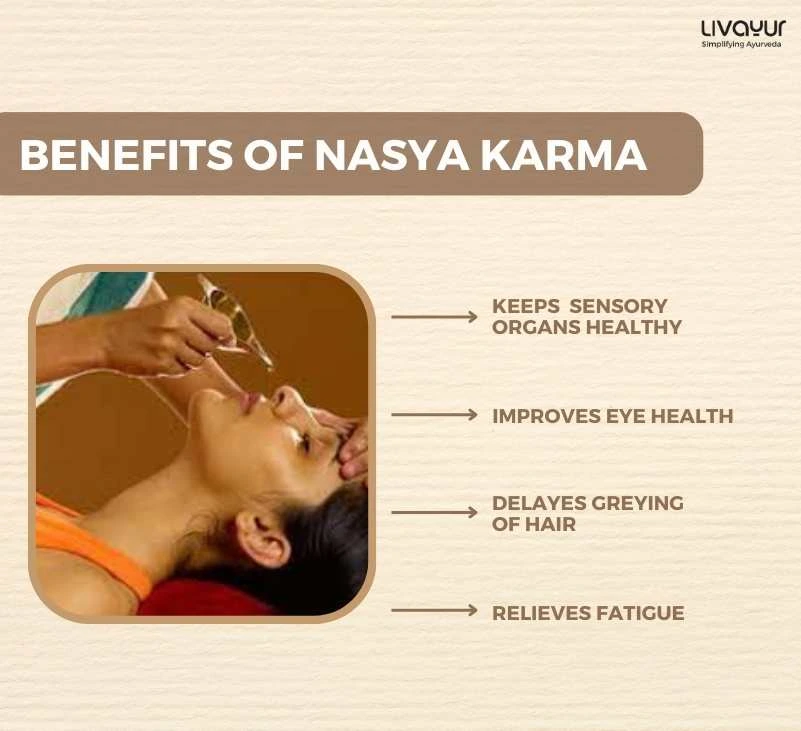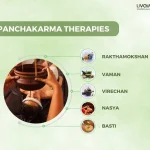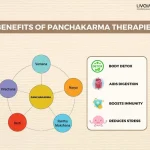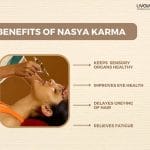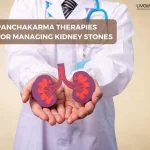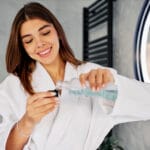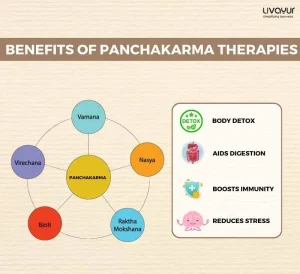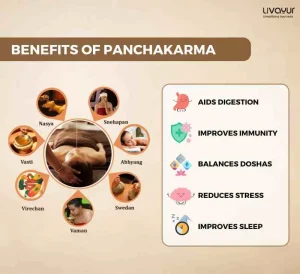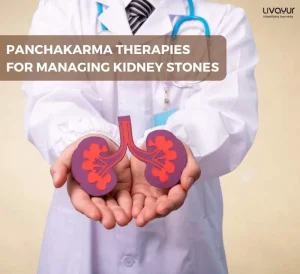
Nasya Karma refers to a procedure of administration of medicines through the nasal route (also known as trans-nasal medication), which is one of the most important routes for administering medications in Ayurveda.
Nasya karma procedure is extremely helpful in promoting health, especially that of the sensory organs. Moreover, it is therapeutically indicated for cleansing of the supra-clavicular part of the human body, palliation of neck and shoulder problems, and management of several systemic diseases, including disorders of the endocrine system.
Pratimarsha Nasya
Pratimarsha Nasya is one type of Nasya Karma that is indicated for everyday practice and is extremely helpful in preventing diseases of the neck, head, oral cavity, as well as respiratory problems.
This form of Nasya Karma has several advantages, such as almost zero contraindications, performed using a low dose (generally 2 drops), the fact that it can be done multiple times in a single day, and the fact that it can be self-administered.
Time of Administering
Pratimarsha Nasya is specifically indicated to be administered after waking up and leaving your bed in the morning, after brushing your teeth, before stepping outside, after brisk walking, exercise, and sexual intercourse, after urinating, defecating, or passing of flatus. Moreover, it also needs to be performed after administering of procedures such as Anjana, Kavala, Shiroabhyanga, after meals, after day sleep, after sneezing, and finally, in the evening and post vomiting.
Methods of Administering
- Lie down in a supine position, with the head and neck in a low position. Instil two drops of sesame oil (Tila Taila) in both nostrils. Pinch your nose once and after releasing, you need to suck the oil up. Spit out the oil when it reaches your throat.
- When you are in a sitting or standing posture, you need to dip the distal part of your little finger (up to the distal skin crease) in Tila Taila and then insert it into one nostril while closing (or pinching) the other nostril. Repeat the same procedure for the other nostril. Again, you need to spit out the oil when it reaches your throat.
Benefits
This simple procedure of performing Pratimarsha Nasya helps in keeping the sensory organs healthy, preventing nasal respiratory allergies, improving the health of the eyes, delaying greying of hair, preventing deafness, relieving fatigue, alleviating the Vata Dosha, and strengthening your neck, denture, face muscles, and temporo-mandibular joints.
Other Types of Nasya Karma
Nasya Karma is further categorised into several types, according to different Acharyas. Presently, the administration is carried out in several forms such as Marsha, Pradhamana, Avapida, Dhooma, and Nasapana.
These diverse forms of administration are not extremely familiar and uniform throughout the country.
Different forms of medicine such as oil, powder, and aqueous have different mechanisms of action through the nasal cavities. Overall, the nasya karma procedure needs the development of a universal standardisation for its correct uniform execution.
Minimising Complications
When it comes to Nasya Karma procedure (or intranasal drug administration), it is the prime duty of the practitioner to consider the fitness of the patient prior to any form of Panchakarma treatment. This is because these treatments are like operative procedures that are used in allopathic medicine. Pre-anaesthetic fitness is essential to prevent complications during surgery. Similarly, pre-fitness for Panchakarma procedures must be considered for improvement in efficacy as well as avoidance of complications.
Some of the most common complications include headache, nasal blockage, heaviness in the head, rhinitis, dryness and nasal irritation, nasal bleeding, and fainting.
To minimise these complications and to achieve the most optimum results, one needs to rule out any existing, nasal pathologies through proper examination prior to administering the procedure. This led to the creation of a Nasya fitness form for clinical practice to further minimise complications.
With Ayurvedic classical literature and nasal anatomy as literary sources, several points were considered for the creation of the present form to successfully rule out nasal pathology. These include examination of the external nose, nasal cavity, nasopharynx, concha, and paranasal sinus through anterior and posterior rhinoscopic examination.
The present fitness form will not only assist in assessing fractures of the nasal bones, obstructions such as DNS (Deviated Nasal Septum), paranasal sinuses, polyps, and turbinate hypertrophies (which are obstacles for drug delivery), but also help in attaining optimum results and avoiding unusual complications.
On a Final Note:
In the present era of increasing atmospheric pollution, one of the most vital Kala (or time of administration) of Pratimarsha Nasya is before stepping outside, which successfully helps to prevent the effects of dust and fumes on the respiratory tract. It is advised to practise Nasya Karma procedure under the guidance of experts.
Disclaimer
This article is from a health and wellness perspective only and does not constitute medical advice. Kindly seek the help of a trained medical practitioner before initiating any treatment.
References:
- ROLE OF NASYA KARMA IN THE MANAGEMENT OF PRATISHYAYA (ALLERGIC RHINITIS). September 2022
This article is reviewed by Dr. Ashwini Konnur




